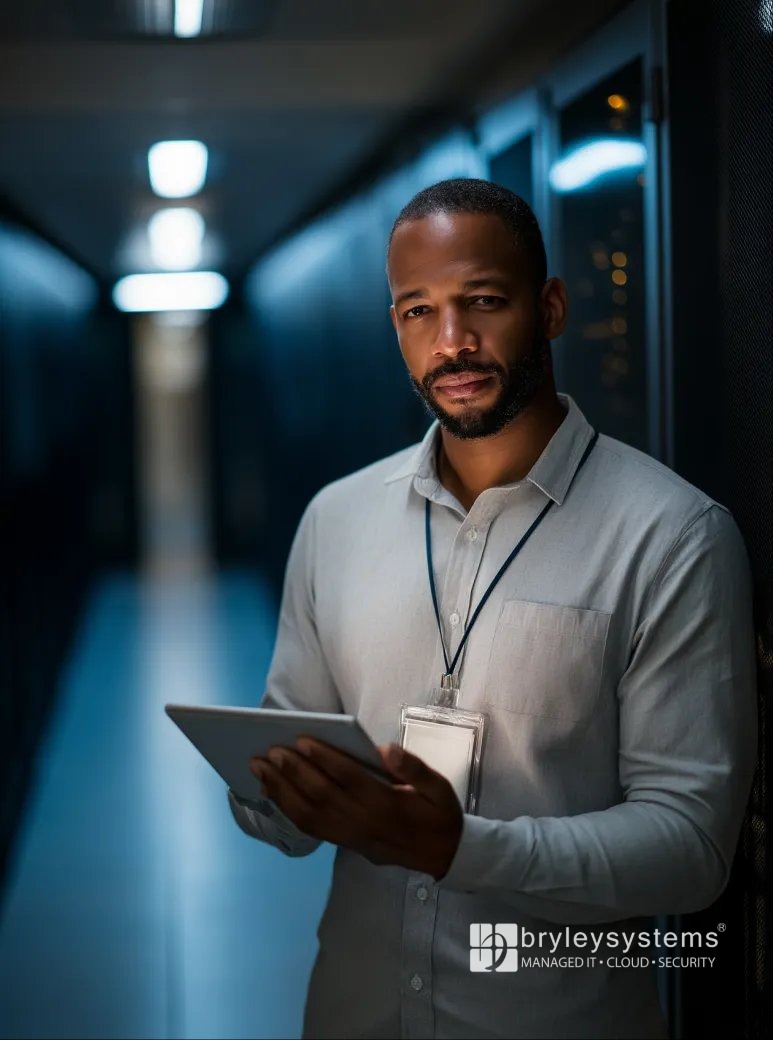Worcester Cybersecurity Services
Combat IT instability and security risks with our proactive, compliance-ready cybersecurity services.
Strengthen defenses with EDR+ITDR that stops device and identity attacks before they disrupt operations or productivity.
Minimize silent vulnerabilities through continuous patching that reduces exploitable gaps attackers rely on.
Reduce breach impact with SOC-backed threat detection that flags and isolates malicious activity immediately.
Reveal hidden risks fast through dark web monitoring that alerts you when stolen credentials surface.
Improve user safety with security awareness training that reduces risky clicks and strengthens team readiness.
Request a Quote for our Cybersecurity Services in Worcester, MA
Why Worcester Organizations Rely on Bryley Systems For Cybersecurity
Delivering proactive threat detection and rapid response to strengthen your security posture.
About Bryley Systems' Cybersecurity Services
Discover how Bryley Systems delivers measurable cybersecurity improvements for Worcester businesses. Gain strategic, proactive protection, local expertise, and a team committed to transparency and continuity, so your IT empowers growth and minimizes disruption.

Empowering Worcester Organizations with Reliable Cybersecurity
Real-Time Identity Oversight
Detects unusual account activity instantly, helping stop unauthorized access before it turns into a costly systemwide breach.
Security in Every Support Step
Every ticket, fix, and system update is handled with a security-first approach, reducing long-term risk while keeping users productive.
Local Experts on Every Alert
Alerts are reviewed by experienced U.S.-based engineers who know your environment, delivering faster, more accurate threat remediation.
Worcester’s Cybersecurity Capabilities That Strengthen Defenses
Bryley’s 24/7 monitoring and threat detection form the backbone of your cyber defense. The team leverages advanced tools to identify suspicious activity, alert you promptly, and neutralize threats before they impact operations. This proactive approach is backed by decades of real-world experience, helping organizations in Worcester avoid costly downtime and data breaches. Expect a continuously updated strategy that adapts to the latest cyber risks and keeps your business resilient.
Security solutions are never one-size-fits-all. Bryley designs layered protection tailored to your organization’s unique systems, workflows, and compliance needs. From endpoint security to firewall management, every measure is selected and implemented to fit your business and industry with robust defenses without unnecessary complexity or cost.
With 95% of companies concerned about cloud security, it’s clear that cloud environments remain a primary target for attackers, especially as more work moves off-premises. Cloud security provides protection across accounts, data stores, and applications by monitoring for unusual activity, enforcing strong access controls, and blocking unauthorized access attempts. Automated threat detection helps identify compromised accounts early, while configuration oversight reduces misconfigurations that often expose sensitive data. The outcome is a more secure, predictable cloud environment your team can depend on every day.
Antivirus Protection serves as the first line of defense against everyday threats like malware, Trojans, and malicious downloads. Continuous scanning and automated threat removal help keep workstations stable, prevent performance slowdowns, and reduce the number of avoidable support requests. By removing known threats before they spread, antivirus supports a cleaner, more predictable IT environment and reduces the chance of user-driven infections that can lead to costly downtime.
Network Security focuses on monitoring routers, switches, firewalls, and traffic patterns to identify unusual behavior or potential intrusions. By applying best-practice configurations and consistent patching, the network becomes harder to exploit and less prone to instability. Continuous monitoring helps detect suspicious traffic early, while structured access controls keep unauthorized users from reaching critical systems. The outcome is a more resilient and predictable network that supports business continuity and reduces the likelihood of widespread impact from cyber events.
Endpoint Protection safeguards the devices employees rely on workstations, laptops, and mobile hardware, by monitoring for malicious activity and isolating threats as soon as they appear. Attackers often target endpoints because they are the easiest entry point into a network. With continuous monitoring, rapid detection, and consistent patching, endpoint risks are significantly reduced. This keeps users productive, prevents threats from spreading laterally, and supports a more secure environment across the entire organization.
Proven Results, Key IT Security Service Metrics That Matter to Worcester Companies
Years serving New England clients
Companies supported
Years of combined experience

Comprehensive Cybersecurity Tailored for Worcester Organizations
Organizations benefit from cybersecurity services designed to address real-world risks and support stable, uninterrupted operations.
Every environment receives a protection plan built around its specific systems, users, and compliance needs, supported by layered security measures such as endpoint defense, identity and device monitoring, and continuous threat detection.
A skilled, service-focused team helps maintain a secure and predictable IT environment, improving security decisions to support both day-to-day productivity and long-term business goals.
Local expertise and practical compliance guidance strengthen risk management efforts and improve overall continuity across the organization.
Cyber Security Services in Worcester

Integrated Security for Maximum Protection
Advanced cyber threats require more than off-the-shelf tools. Bryley integrates EDR and ITDR solutions directly into your managed IT plan, no add-ons needed. This seamless integration means faster response to incidents, improved threat visibility, and peace of mind. Regular updates and continuous monitoring ensure your systems remain protected against emerging threats, while your team receives clear communication and actionable recommendations at every step.
Reduce Cyber Risk Today
Receive practical recommendations built around your systems, compliance needs, and day-to-day workflow.

Continuity-Focused Cybersecurity Support
Downtime can be costly. Bryley’s continuity-driven mindset keeps your business running, even during cyber incidents. Comprehensive backup strategies, disaster recovery planning, and rapid response protocols are built into every service agreement. The focus is not just on restoring systems, but on minimizing disruption and empowering your organization to maintain critical operations, no matter what.
Explore More IT Services in Worcester
See how Bryley can support your technology and security needs.
Answers to Worcester's Most Common Cybersecurity Service Questions
Cybersecurity services provide layered protection across devices, identities, networks, and cloud environments. This includes advanced threat detection, endpoint protection, controlled access, email security, and monitoring that identifies unusual activity before it becomes disruptive. The goal is to reduce exposure, simplify risk management, and keep systems stable for everyday operations.
When a threat is detected, automated tools help isolate the affected device or account to limit the spread. The engineering team reviews the alert, investigates the cause, and follows established procedures to resolve the issue quickly and safely. After remediation, additional steps or improvements may be recommended to strengthen the environment and prevent similar occurrences.
Yes. Cybersecurity services include support for common compliance frameworks by implementing practical controls, strengthening documentation, and improving overall security posture. The goal is to make compliance more manageable while enhancing security measures aligned with your operational needs.
Even relatively small businesses can face downtime costs ranging from $137 to $427 per minute, making stability a critical priority. Prevention-focused measures such as endpoint protection, monitoring, secure configurations, and continuity-ready backups help reduce the likelihood of system failures or interruptions caused by cyber events. By addressing risks before they escalate, these protections work together to maintain stability and support uninterrupted business operations.
Each environment is evaluated to understand its systems, workflows, and risk areas. From there, a protection plan is tailored to match specific needs, selecting the right tools, controls, and monitoring are put in place. This approach supports long-term stability and helps enhance security decisions that align with business goals.

Build a Safer IT Environment in Worcester With Tailored Cybersecurity
Get more reliable operations with proactive monitoring that keeps systems stable and reduces disruptions.
Gain stronger security through layered protection that limits vulnerabilities and safeguards critical data.
Achieve cost clarity with predictable monthly agreements that support better budgeting and planning.
Drive faster resolutions through responsive support that reduces the burden on internal teams.
Maintain compliance readiness through guided oversight that keeps controls aligned with regulatory expectations.














































